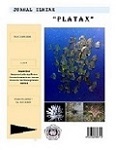Seagrass Community Structure in Mangket Beach Water, Kema District, North Minahasa Regency
DOI:
https://doi.org/10.35800/jip.v12i1.50365Keywords:
Mangket Beach, seagrasses, community structuresAbstract
The purpose of this study was to determine the types of seagrasses, density, relative density, frequency, diversity index, dominance index, and environmental factors in Mangket coastal waters. This research method is the quadratic and line transect. This research was conducted in the waters of Mangket Beach, Kema District, North Minahasa Regency on November 27, 2022. There were 3 species of seagrass found in Mangket Beach waters, namely, Cymodocea rotundata, Cymodocea serrullata, and Enhalus acoroides. The number of seagrass species stands at the study site ranged from 105-814 individuals, species density (4.38-33.92 individuals/m2), relative density (6.54-50.72%), frequency of presence (1.67-4 .00), relative frequency (17.24-41.38%), diversity index H'= (0.38) and dominance index (0.004-0.26). The environmental conditions in the waters are temperature 29.5°C, salinity 32‰, and sandy and sandy mud substrates.
Keywords: Mangket Beach, seagrasses, community structures.
Abstrak
Tujuan penelitian ini adalah untuk mengetahui Struktur Komunitas Lamun meliputi jenis-jenis lamun, kepadatan, kepadatan relatif, frekuensi, frekuensi relatif, indeks keanekaragaman, indeks dominasi dan faktor lingkungan perairan pantai Mangket. Metode penelitian ini adalah kuadrat dan line transek. Penelitian ini dilaksanakan di perairan Pantai Mangket Kecamatan Kema Kabupaten Minahasa Utara pada tanggal 27 November 2022. Spesies lamun yang ditemukan di perairan Pantai Mangket berjumlah 3 yaitu, Cymodocea rotundata, Cymodocea serrullata dan Enhalus acoroides. Jumlah tegakan spesies lamun di lokasi penelitian berkisar dari 105-814 individu, kepadatan spesies (4,38-33,92 individu/m2), kepadatan relatif (6,54-50,72%), frekuensi kehadiran (1,67-4,00), frekuensi relatif (17,24-41,38%), indeks keanekaragaman H’= (0,38) dan indeks dominasi (0,004-0,26). Kondisi lingkungan di perairan yakni suhu 29,5°C, salinitas 32‰, substrat lumpur berpasir dan berpasir.
Kata Kunci: Pantai Mangket, lamun, struktur komunitas.
References
Fachrul, M.F., 2007. Metode Sampling Ekologi. Bumi Aksara: Jakarta.
Krebs, C.J. (1989). Ecological Methodology. New York: Harper & Row Inc. Publisher.
Krebs, C, J. 1999. Ecological Methodology. Second Edition. Addison Wesley Longman, Inc. New York.
Kondoy, K. I. 2016. CO2 Absorptibility of Seagrass, Enhalus acoroides, From Tongkaina Coast, North Minahasa, North Sulawesi Province. Jurnal Ilmiah PLATAX, 4(1), 31-36.
Sjafrie, N.D.M., 2018. Potensi Energi Lamun Untuk Mendukung Pelestarian Dugong (Dugong Dugon) Di Desa Berakit Dan Desa Pengudang Pulau Bintan. Widyariset, 4(2), pp.113-122.
Suhud, M.A., 2012. Struktur Komunitas Lamun Di Perairan Pulau Nikoi. Jurnal Penelitian. Jurusan Ilmu Kelautan Fakultas Ilmu Kelautan dan Perikanan Universitas Maritim Raja Ali Haji, Tanjungpinang.
Supriyadi., , R.F Kaswadji., D.G., Bengen, dan M. Hutomo, 2012. Komunitas lamun di pulau barranglompo Makasar: Kondisi dan karateristik habitat. Jurnal maspari. Vol 4 (2). Hal 148-158
Wangkanusa, M. S., Kondoy, K. I. F., dan A. B. Rondonuwu, 2017. Identifikasi Kerapatan dan Karakter Morfometrik Lamun Enhalus acoroides Pada Substrat yang Berbeda di Pantai Tongkeina Kota Manado. Jurnal Ilmiah Platax, 5(2), 210 – 220
Downloads
Published
How to Cite
Issue
Section
License
Copyright (c) 2024 Paramitha G. Wakkary, Stephanus V. Mandagi, Khristin I. F. Kondoy, Renee Ch. Kepel, Febry S. I. Menajang

This work is licensed under a Creative Commons Attribution-NonCommercial 4.0 International License.
COPYRIGHT
Authors who publish with this journal agree to the following terms:
Authors hold their copyright and grant this journal the privilege of first publication, with the work simultaneously licensed under a Creative Commons Attribution License that permits others to impart the work with an acknowledgment of the work's origin and initial publication by this journal.
Authors can enter into separate or additional contractual arrangements for the non-exclusive distribution of the journal's published version of the work (for example, post it to an institutional repository or publish it in a book), with an acknowledgment of its underlying publication in this journal.
Authors are permitted and encouraged to post their work online (for example, in institutional repositories or on their website) as it can lead to productive exchanges, as well as earlier and greater citation of the published work (See The Effect of Open Access).






































